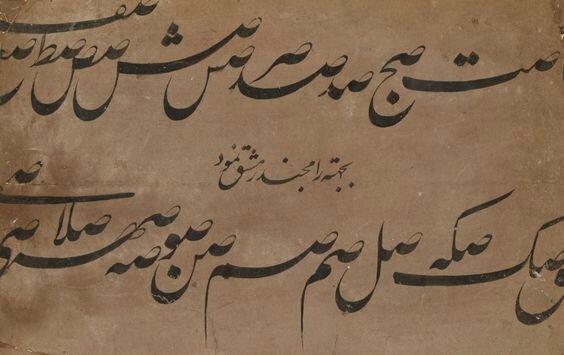Jahangir offers jewels to Asaf Khan, India, Deccan, probably Golconda, late 17th century
gouache with gold on paper, buff paper borders flecked with gold, reverse with a calligraphic exercise in black nast'aliq script on brown paper with wide green borders flecked with gold; painting: 40.5 by 56.8cm; with borders 44.8 by 59.6cm; calligraphic panel: 20.9 by 32.5cm.
Note: This large painting is a late seventeenth-century Deccani version of a well-known imperial Mughal miniature in the Late Shah Jahan Album (Freer/Sackler Gallery, Washington, S.1986.407). The Mughal original, datable to circa 1650, shows the Emperor Jahangir giving a tray of jewels and a sarpech to Asaf Khan (d.1641), his brother-in-law (brother of Nur Jahan) and the father in law of Shah Jahan (Mumtaz Mahal's father). The Sackler Gallery online catalogue comments that it was this close relationship between Asaf Khan and two generations of Mughal emperors led to Shah Jahan to commission "a posthumous visual confirmation of Asaf Khan's extraordinary status and importance."
Jahangir with Asaf Khan and Shayista Khan, from the Late Shah Jahan Album, Mughal School, Mughal dynasty, Reign of Shah Jahan, ca. 1650. Opaque watercolor, ink, and gold on paper mounted on paperboard. H x W (overall): 44.9 x 33 cm (17 11/16 x 13 in). Purchase — Smithsonian Unrestricted Trust Funds, Smithsonian Collections Acquisition Program, and Dr. Arthur M. Sackler, S1986.407 © 2017 Smithsonian Institution
The present painting was probably executed in Golconda in the late seventeenth century. In style (precise but stiff and somewhat less refined version of the seventeenth-century Mughal mode) and scale (very large - the seated figure of Jahangir is 29cm tall) it relates to other late seventeenth-century works executed in the Deccan in the period after the Mughal armies conquered those states (Golconda fell to the Mughals in 1687), especially portraits and court scenes collected by Dutch and other European visitors. In particular, a series of very large portraits of Mughal emperors, princes and noblemen, two examples of which are lots 127 and 128 in this sale, bears a close resemblance in style and scale to the present work (see those lots for further information). These were executed in Golconda or perhaps further north in the Deccan between 1690 and 1700 and on the evidence of the early Dutch inscriptions and labels were collected in India by a Dutch visitor (see Sotheby's London, 13/14 April 1976, lot 267).
Another element that links the present work to the Deccan at this period is the rather awkwardly painted falcon on a stand between Jahangir and Asaf Khan. This is an additional element in the present work that does not appear on the Mughal original, the latter which is otherwise reproduced verbatim. Similar depictions of falcons appear in several other late seventeenth-century Golconda works collected by Dutch travellers (Sotheby's London, 11 October 1982, lot 45; Hurel 2010, no.235, p.173) as well as other Deccani works of the period (see Sotheby's New York, 14 December 1979, lot 51).
There are two other late seventeenth-century Deccani versions of Imperial Mughal court scenes. One shows a durbar of Shah Jahan (Christie's London, 4 October 2012, lot 169), the other shows Shah Jahan seated on a throne holding a sarpech with a courtier in attendance (Sotheby's London, 20 July 1977, lot 41). The latter is particularly close in style to the present work.
Sotheby's. Arts of the Islamic World, London, 26 Apr 2017, 10:30 AM

/https%3A%2F%2Fprofilepics.canalblog.com%2Fprofilepics%2F1%2F0%2F100183.jpg)
/https%3A%2F%2Fstorage.canalblog.com%2F03%2F02%2F119589%2F96711876_o.jpg)
/https%3A%2F%2Fstorage.canalblog.com%2F11%2F31%2F119589%2F94773502_o.jpg)
/https%3A%2F%2Fstorage.canalblog.com%2F20%2F83%2F119589%2F94772815_o.jpg)
/https%3A%2F%2Fstorage.canalblog.com%2F26%2F72%2F119589%2F75604929_o.jpg)
/https%3A%2F%2Fstorage.canalblog.com%2F59%2F60%2F119589%2F26458628_o.jpg)





/http%3A%2F%2Fstorage.canalblog.com%2F06%2F39%2F119589%2F129007933_o.jpg)
/http%3A%2F%2Fstorage.canalblog.com%2F83%2F41%2F119589%2F128989180_o.jpg)
/http%3A%2F%2Fstorage.canalblog.com%2F65%2F49%2F119589%2F128551133_o.jpg)
/http%3A%2F%2Fstorage.canalblog.com%2F11%2F78%2F119589%2F126903004_o.jpg)